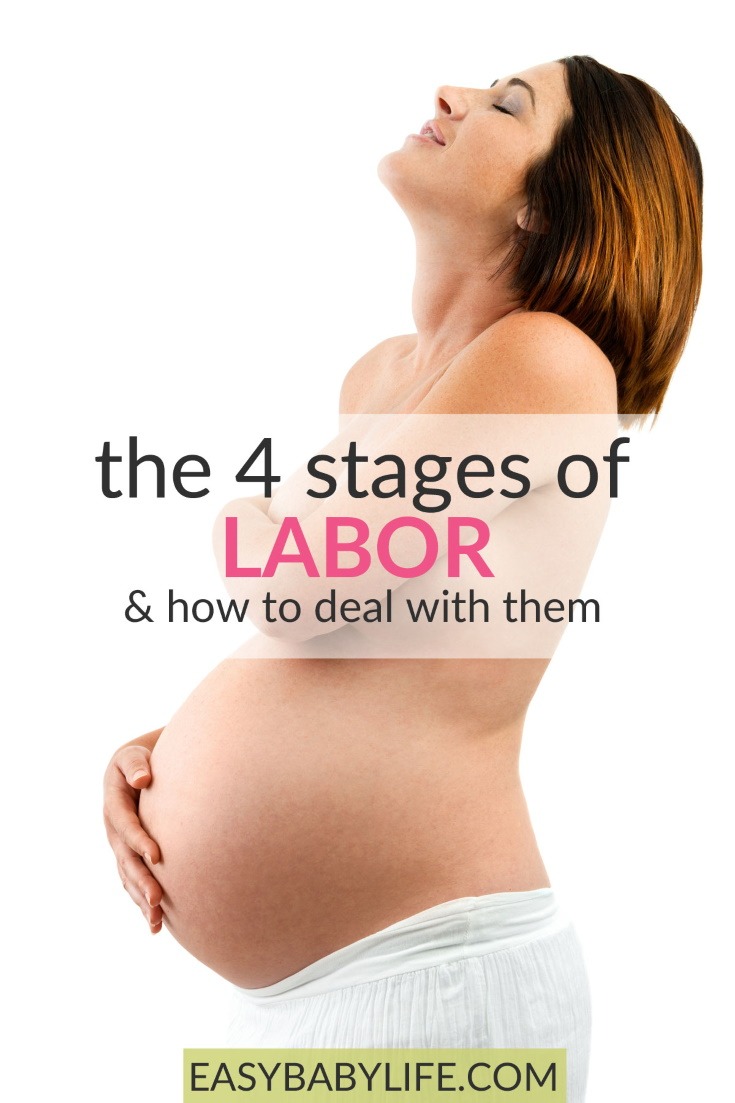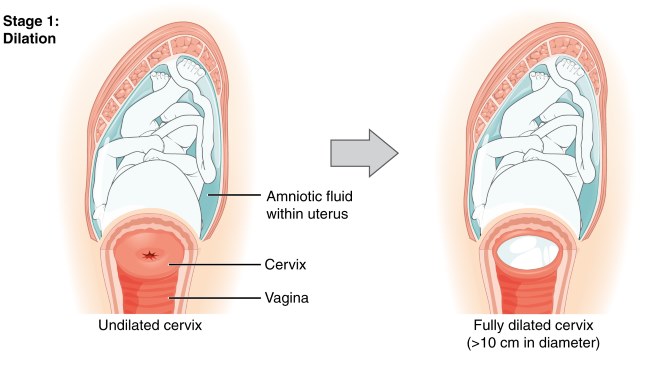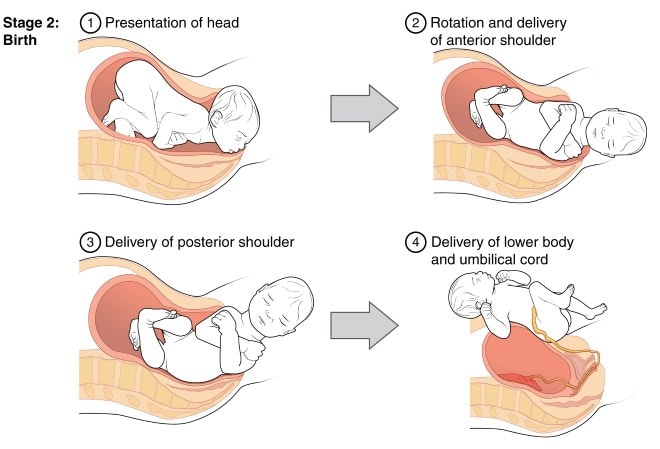This article details the four stages of labor, and how to deal with them for the best possible birth experience.

Giving birth is one of the weirdest and most special experiences that a woman can have. The worrying before, the intense process when going through the different stages of labor, and then the memory of it afterward. Together with meeting your new life companion, of course.
Although when you are in the throes of labor pains you may feel like it is stretching on forever, it does end. Knowing the different stages of labor can help you understand what is going on in your body and what is coming up next.
Being prepared will also probably help you deal with the pain more effectively.
The Stages of Labor Explained
- The First Stage – from Zero to Intense
- The Second Stage- Push, Push
- The Third Stage- the Placenta
- The Fourth Stage- Recovering
The First Stage – from Zero to Intense

The first stage of labor actually has three parts:
The first part is early labor. This is the time when your cervix will begin dilating. You may not feel strong contractions during early labor. Many women compare them to menstrual cramps. The contractions are usually felt in the lower back and in the lower part of your abdomen. These early contractions usually last between 30 and 60 seconds and come anywhere from five to twenty minutes apart. During this time you will dilate from 0 to 1,2 inches (0 to 3 centimeters).
The duration of the early stages of labor varies with each woman. For some, the very first part of this process actually goes on for a couple of weeks and practically without the woman noticing. For others, it is really part of the “real” process of giving birth and the contractions can be painful. If they are, try relaxing and breathing deeply during the contractions. If they are not very painful, the best you can do is probably to try to simply ignore them, especially since it may still be many hours or even days before your baby is born.
After early labor comes active labor when you will dilate from 1.6 to 3 inches (4 to about 8 centimeters). This stage of labor usually lasts between 3 and 8 hours and sure is harder to ignore! Your contractions will intensify and you will feel the pain radiating from either the back towards the front or vice versa. Some women describe it like waves. It starts small and grows in intensity and then fades away. The contractions come much closer together during the active stages of labor.
Try taking a warm shower, changing positions, and walking to help deal with the pain. Or, if it makes you feel better, simply relax. Your spouse or support person can do miracles during this stage of labor by helping you to breathe through the most painful contractions and by massaging you. One particular type of massage that helped me a lot was a quite hard massage at the lower part of my back during the contractions.
If you don’t participate in a prenatal class to learn techniques for this together with your partner, the two of you miss a great opportunity to affect your childbirth in a great way!
Transition is the last of the first stage of labor. This is when your cervix dilates from 3 to 4 inches (8 to 10 centimeters). This is a very intense time. The contractions come closer together until they may seem like they are one on top of the other, and your body may do strange things to deal with the changes. Some women shake or become nauseous. Others get hot and cold sweats.
This is the shortest stage of labor, but it is the hardest. It typically lasts between fifteen minutes and three hours. This is a stage that many women opt for pain relief, decide to go home or threaten to kill their husband who did this to them…
While you might need medical pain relief or at least laughing gas to cope with this stage, remember to keep breathing and relaxing. If you start fighting the contraction, it will take longer and be more painful. The pain may be almost unbearable, but it is not dangerous. It is just awful! And it will soon be over.
Refrain from pushing until your health care professional tells you that you are complete to avoid tearing the cervix.
The Second Stage- Push, Push

During the second stage of labor, your baby will be born. Your doctor or midwife will guide you when to push. The trick is to push and be relaxed at the same time. (How in the world is that possible?!) Well, it is. You are supposed to use your stomach muscles to push your baby down while keeping the pelvic muscles relaxed to make it as easy as possible for the baby to be delivered. To learn more about how to push during labor, click here.
Listen to the doctor and stop when they tell you. If you push too hard when you are not supposed to, it can result in tearing or hemorrhoids.
The head will be delivered first and when it crowns you will feel a burning sensation. This has been called the “ring of fire”. Your body has natural painkillers and after the initial burning, it will fade to be less intense. After the head is delivered you will probably only need to push once or twice gently to deliver the rest of your baby. When the baby is delivered, most hospitals will lay him or her on your stomach so that you can see them. They will dry the baby off a little bit and clear his airways so that he/she can take his first breath. The nurses will put wrist and ankle bands on the baby and a matching bracelet on you and possibly the baby’s father. Only after that with the umbilical cord be cut (maybe by the proud new dad?).
In some hospitals, they will weigh your baby and measure his or her length and head circumference almost directly after the delivery, while in other places they wait and let you all rest together first. I prefer the calmer route…
You can ask in your birthing plan that they wait with as many examinations as possible and instead let you hold your baby until you decide.
The Third Stage- the Placenta

The third of the stages of labor is the delivery of the placenta. Your uterus will continue to contract until the placenta is delivered. The doctor will likely push on and rub your abdomen to help the placenta dislodge from the uterine wall. There may be quite a lot of blood at this point, but don’t let that alarm you. Some women find this stage of labor to be painful, others report only mild discomfort. I have given birth twice and honestly don’t even remember delivering the placenta at all. I guess I was totally occupied with our baby on my chest.
When the placenta is delivered the doctor will check to make sure it is healthy and intact. The doctor will then repair any damage such as an episiotomy or stitch up any tears.
If you find it unbearable to be touched at all at the area of your vagina at this point in time or if simply hurts even without any touching, you can ask for some anesthetic ointment. This is the time when you want to focus on your newborn baby, rather than on any stinging sensation from giving birth!
The Fourth Stage- Recovering
Now, in one way your labor and delivery are now over. However, your uterus will continue to work for quite some time; the fourth stage of labor. The contractions to slowly take your uterus back to its normal size are usually not very painful at all, particularly not the first time you give birth. For some reason, they tend to be more painful the second childbirth and on. But it is still nothing compared to giving birth! Ask for a painkiller that is safe with breastfeeding (if you plan to breastfeed).
The fourth stage of labor also includes the recovery time for the mother after giving birth. If you gave birth at a hospital, you will generally stay there for two days following a normal vaginal delivery, and four days after a C-section. You will be very tender and it will probably hurt to move. The nurses and doctors will check on you frequently to make sure that your bleeding is steadily decreasing and you are not passing any significant blood clots. They will check your blood pressure and swelling, and you will be encouraged to drink lots of water. They will want to make sure you can urinate and have a bowel movement as well.
This is a great time to bond with your baby and ask any questions you might have. It is also an excellent time to get hands-on expert advice on how to breastfeed. At the hospital, I asked a nurse to help me out every time I was about to breastfeed, to make sure my baby latched on properly and that I sat or lay down in a good position both for me and for my baby. Use this expertise even if it is not your first baby – it is so easy to forget how to do it and it is so unnecessary to have a painful start!
Curious about what your post-pregnancy body will be like? Read this post.

Paula Dennholt founded Easy Baby Life in 2006 and has been a passionate parenting and pregnancy writer since then. Her parenting approach and writing are based on studies in cognitive-behavioral models and therapy for children and her experience as a mother and stepmother. Life as a parent has convinced her of how crucial it is to put relationships before rules. She strongly believes in positive parenting and a science-based approach.
Paula cooperates with a team of pediatricians who assist in reviewing and writing articles.






